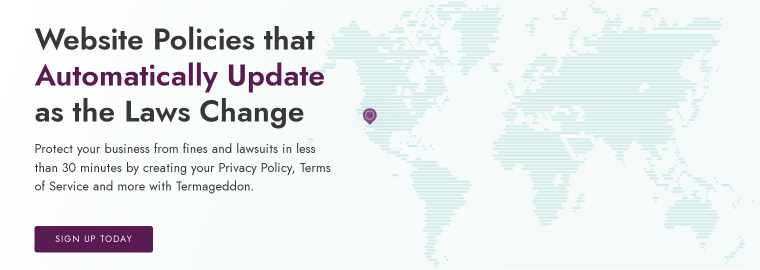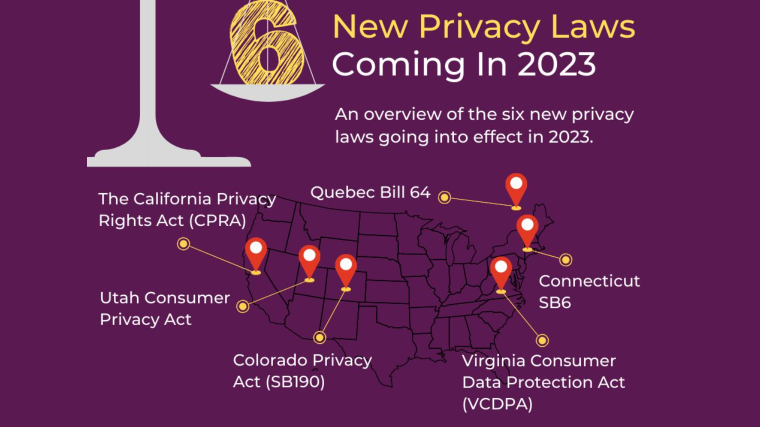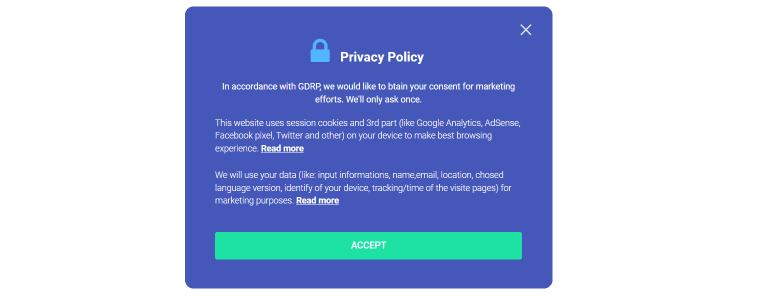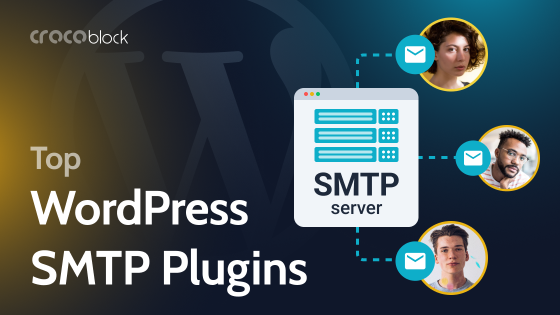We get it. Privacy Policies can be confusing. After all, they’re legal documents designed to do two critical things:
- help websites comply with all applicable privacy laws;
- provide website visitors with a way to see how and why a particular site uses their personal data.
It can be overwhelming for any website owner that hasn’t passed the Bar exam in their free time to create a proper Privacy Policy, let alone manage it to ensure it stays updated as laws change.
We’ve partnered up with Termageddon, a Privacy Policy generator founded by a licensed privacy attorney, to provide the basics that every web agency needs to know about Privacy Policies.
Please note that this article is provided for informational purposes only and should not be considered legal advice.
Table of Contents
What Is a Privacy Policy?
A Privacy Policy is a statement published on a website or application that explains how you collect, use, and disclose personal information (name, email, phone number, IP address, etc.), as well as your privacy practices. A Privacy Policy needs to contain the exact disclosures required by the privacy laws that apply to a business.
Contrary to popular belief, Privacy Policies weren’t created to give web agencies headaches. They actually serve an important purpose: to protect individual Internet users’ online data and personal information.
By including a proper Privacy Policy on websites, you are making it clear to visitors that you respect their online privacy and are fully transparent about how your website uses their personal information.
Do All Websites Need a Privacy Policy?
The law doesn’t require all websites to have a Privacy Policy. Privacy laws apply to you only if you collect people’s personal information. Most modern websites intend to help website owners generate leads and sales. They track users behind the scenes for security, analytics, and marketing purposes. Essentially, privacy laws require website owners to have a Privacy Policy, and each law lays out exactly what your Privacy Policy needs to disclose.
For example, suppose a website collects personal information from customers (emails, names, phone numbers, IP addresses, etc.). In that case, it may be required to have a Privacy Policy by multiple privacy laws – even if the website belongs to a small business or blog. While there are numerous examples of how a website may collect, use, or store this information, some of the most common ways are through contact forms, newsletter sign-ups, third-party payment tools, analytics tools, marketing/tracking pixels, and security tools like reCAPTCHA.
It’s also important to note that privacy laws protect individual website users, not businesses. So even if your state/area doesn’t have a privacy law, you may be required to comply with the privacy laws of other states or countries if their residents interact with these tools on your website.
Who’s Responsible for a Website’s Privacy Policy: The Agency or the Client?
From a legal standpoint, the website owner (client) is responsible for the site’s policies. However, as the one building the website, it’s a good idea to inform clients about the importance/need for proper website policies. Typically they assume web developers include these pages in the website.
Web agencies should stress the importance of proper website policies but let the client decide what they’d like to do. Tools like this free Website Policies Waiver can help you protect your agency by informing your clients that it is their responsibility to create policies and keep them up to date.
How Do I Create a Privacy Policy?
The two best ways to ensure you get a Privacy Policy tailored to your website are hiring a privacy attorney or using a Privacy Policy Generator. While a privacy attorney to provide you with legal advice is always the best route, the reality is that it can be too expensive for a small business. Privacy Policy generators are an excellent, more affordable alternative, as they are not legal service providers. Instead, they are tools for generating comprehensive policies quickly (and keeping them up to date with new disclosures).

A Privacy Policy Generator is quite easy to use. It requires you to answer a few questions about the business. Then the tool uses this information to create all the disclosures needed within a website’s Privacy Policy.
That said, not all Privacy Policy generators are the same. A good generator will do the following:
- Have an “About Us” page that lets you know the team behind it. Make sure a privacy attorney is involved with the company!
- Find out what laws apply to you before generating a policy. Each law has its own disclosure requirements. The best Privacy Policy generators will first ask you a series of questions to determine what laws apply to you.
- Adapt as you answer questions about your website/business. Privacy laws have many conditional-based disclosures; therefore, a good generator will change its questionnaire based on how you answer particular questions.
- Have upfront, easy-to-understand pricing. Website policies are complex enough. Pricing should be straightforward.
- Update website policies automatically as privacy laws change. Six new laws have gone into effect in 2023. Many more have been passed and will be enacted over the coming years. Each of these laws has new disclosure requirements which you may be required to provide.

Many generators have an agency partner program now. Find a provider that invests its time into helping you (the agency) learn about the basics of policies, gives you a free license, and helps you educate your clients on what they can do for their own policies. We recommend embracing these regulations in the web design industry as you can give more value to your customers as you help protect them.
How Can a Privacy Policy Be Displayed on a Website?
Displaying a Privacy Policy conspicuously on websites is of utmost importance. It establishes transparency and builds trust with visitors. Ultimately, businesses fulfill legal obligations by making a Privacy Policy readily available.
The way legal statements appear on websites depends on various factors. Some policies require consent through a clear affirmative act. The affirmation may involve checking a box before submitting personal information. However, checkboxes are not always necessary.
Another factor is the website owner’s design goals. In fact, software tools allow for presenting privacy policies in an appealing way that aligns with the brand. And if your agency works with WordPress, you’ll need versatile plugins to incorporate the statements with policies information nicely.
Let’s see some Privacy Policy examples by Crocoblock. Its best solutions for displaying a Privacy Policy are JetThemeCore, JetPopup, and JetFormBuilder plugins.
Footer and header
One effective way to present a Privacy Policy is by creating a single page dedicated to the policy’s information. With the help of JetThemeCore’s Theme Builder feature, this task is straightforward and time-efficient. You can easily add templates and customize the page to match your website’s design. It is common to place a link to a Privacy Policy in prominent areas such as the header and footer of the website.

Remember that users must be able to access a Privacy Policy from every page that collects their private information. The best practice is to create header or footer templates with relevant links to use everywhere on the site. Again, JetThemeCore is the tool that comes in handy. It allows adjusting templates for one exact page or the entire site, reducing web admin’s work hours.
Pop-ups
Another option for presenting privacy policies is by using pop-ups. JetPopup is a versatile solution for building and customizing all types of pop-ups suitable for different purposes. For example, full-page pop-ups are ideal for displaying full information about the data collected on the site. Smaller pop-ups are for shorter privacy notices, such as GDPR compliance. They can appear in the middle of a screen as lightboxes or narrow bars at the top or bottom of a web page.

The advantage of pop-ups is that you can configure them to appear every time a user opens a new page, guaranteeing that they know about the policies.

With the JetPopup, you can add links to separate privacy policy pages or make users accept the policies before proceeding to the actual page. The plugin also provides extensive customization options to match the pop-up design with your brand. Similar to controlling the placement of links in footer and header templates, managing where pop-ups appear is easy. All pop-ups and controls are accessible on one page in your backend admin panel.
Forms
Another way to ensure your visitors are able to find a Privacy Policy is by including a link in all forms that collect user information. With the JetFormBuilder plugin, you can create an “accept privacy policies” checkbox and set it as a condition for form submission. This confirms the users agree to your policies before providing their information.
FAQ
A Privacy Policy is a statement that outlines how a website, or an app, uses and stores personal information gathered from users or customers.
The websites that collect viewers’ private information, such as their names, email addresses, or payment details, need a Privacy Policy.
To ensure the site’s legal compliance, you can hire a privacy attorney. An affordable option for a small business is to use a reputable privacy policy generator.
No. A Privacy Policy template is a static document that doesn’t change. A Privacy Policy generator creates a solution specifically tailored to your business and alerts you when new laws come into effect.
The main thing to consider when displaying a Privacy Policy on a website is whether it is noticeable to visitors. A common location to place a Privacy Policy link is in the web page’s footer or in the opening pop-up.
Summary
To ensure compliance and protect the privacy of visitors and customers, websites that collect any data must have a privacy policy. Using a generator like Termageddon is a best practice to generate privacy policies and keep them up to date. Investing in a quality Privacy Policy generator will help agencies protect their clients better from potential fines and lawsuits, turning it into a new recurring revenue stream.
With the right software, you can choose where to display a Privacy Policy. Crocoblock plugins allow you to present it as single pages or pop-ups and place relevant links in footers, headers, or forms. Finally, the customization options can make a Privacy Policy visually appealing and consistent with the site’s branding.

